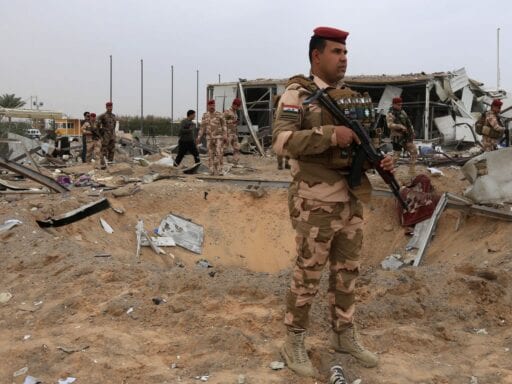The US has set a red line: kill an American, be met with force.
A day after an Iran-backed militia killed one British and two American troops in Iraq, the United States responded by bombing five of the group’s weapons facilities on Thursday night — escalating an already intense rivalry with Tehran that could turn into a bigger war.
On Wednesday, a group believed to be Ketaib Hezbollah launched about 30 rockets into Camp Taji, a large base north of Baghdad hosting members of the US-led coalition to defeat ISIS. The rocket attacks killed three service members — two Americans and one British soldier — while injuring 14 other coalition members. Ketaib Hezbollah has yet to take responsibility for the attack, though in a Wednesday statement they praised those who conducted the “precision jihadi operation.”
Marine Gen. Kenneth McKenzie, the top officer of US troops in the Middle East, told reporters on Friday morning that America has intelligence that proves Ketaib Hezbollah was behind the rocket attack.
The group was always a likely culprit. Ketaib Hezbollah was behind the killing of an American contractor in Iraq last December, to which the US responded by striking members of the group. That prompted the Iran-backed militia to organize a New Years’ Eve protest at the US Embassy in Baghdad in which some members got inside the compound, though no American was hurt.
As a response, a few days later President Donald Trump ordered the killing of top Iranian leader Qassem Soleimani — a move meant to signal any threats on, or murders of, Americans would be met with a harsh response.
Hence the retaliatory strikes on Thursday night against Ketaib Hezbollah: The group killed Americans, so the US hit back.
“The United States will not tolerate attacks against our people, our interests, or our allies,” Secretary of Defense Mark Esper said in a Wednesday night statement. “As we have demonstrated in recent months, we will take any action necessary to protect our forces in Iraq and the region.”
How the attack on Ketaib Hezbollah happened
A US military PowerPoint slide released to reporters shows the five targets were all near Baghdad and housed materials to build advanced weapons like rockets. Selecting those facilities to bomb, per a Defense Department statement, was meant “to significantly degrade their ability to conduct future attacks against” coalition forces in the region.
/cdn.vox-cdn.com/uploads/chorus_asset/file/19796141/Screen_Shot_2020_03_13_at_10.34.03_AM.png) US Central Command
US Central CommandIn his Pentagon briefing, McKenzie said all the targets were hit by coalition manned fighter aircraft at 6:00 pm Washington time on Thursday. He also noted the military is “confident we have effectively destroyed these facilities and expect they will no longer be able to house the type of advanced, Iranian-supplied weapons that were used” in the Camp Taji attack.
As of now, there is no indication that anyone was killed in the bombings, but an official assessment is still ongoing.
Experts agree the US made a smart call with its response.
“The US retaliation seems pretty proportional and reasonable,” says Ilan Goldenberg, the Defense Department’s Iran team chief from 2009 to 2012.
“It was the easiest option, or at least one that would be the least damaging in the mind of the administration to send a signal,” Phillip Smyth, an expert on Iran-backed militias at the Washington Institute for Near East Policy, told me. However, he argues the US should “hit fast and hit hard” at more targets instead of bombing empty warehouses.
Some reports indicate that US defense officials say the American attack was calibrated so as not to escalate the conflict with Iran.
The US military is taking extra steps to deter another assault on American troops in the Middle East. Esper granted McKenzie’s requests for two aircraft carriers in the region, the general said, the first time that’s happened since 2012. And US forces will now move Patriot systems to Iraq to better defend against incoming missiles. That will require hundreds of new troops to head into the country to man the missile-defense batteries.
Which means Washington aims to beef up its presence so Ketaib Hezbollah doesn’t launch any more surprise attacks, especially after this last one seems to have caught coalition forces off guard.
Why Ketaib Hezbollah attacked now
Experts say one of Ketaib Hezbollah’s main motivations for this week’s attack was to put pressure on the US to lift sanctions on Iran. According to McKenzie, the militants — which are closely aligned with Tehran — have launched 12 rocket attacks against coalition forces over the last six months likely in service of that goal.
But why did Ketaib Hezbollah up the stakes now? Smyth says it’s because Iran is trying to show “we still got this” after suffering the deaths of Soleimani and other top militia leaders in January. What’s more, Iran wants its allies in Iraq to know “we’re in it for the long haul” and that the US — which has a strained relationship with Baghdad now — isn’t as vital a partner.
There’s also a chance Tehran wanted a propaganda win as it suffers from a Covid-19 outbreak in the country. As of March 13, the country has over 11,000 confirmed cases, major cities are digging large burial trenches, and top officials have died or have been infected by the disease. By killing Americans, the regime can shift the narrative of its mismanagement of the crisis at home.
But the cycle of violence doesn’t look like it will end soon. A cessation of conflict would only happen if the US and Iran strike some sort of deal, perhaps a freeze on Iran’s nuclear program in exchange for sanctions relief. That’s unlikely to happen in the near term, though, which means this may not be the end of the US struggle against Ketaib Hezbollah.
“We’re in this low-ebb intensity conflict probably until the end of the Trump administration,” says Goldenberg.
Author: Alex Ward
Read More



